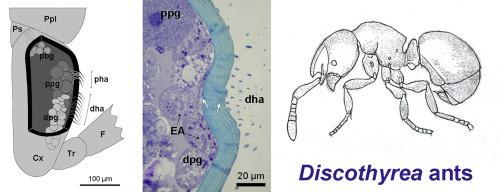Arthropod Structure & Development ( IF 1.7 ) Pub Date : 2020-08-17 , DOI: 10.1016/j.asd.2020.100981 Johan Billen , Chung-Chi Lin , Flavia A. Esteves

|
Workers, queens and males of all examined Discothyrea species of the ‘sauteri group’, that have laterally expanded frontal lobes and well-developed antennal scrobes, are characterized by two hairy areas on the outer surface of their procoxae. Histological and ultrastructural examination of Discothyrea sauterirevealed that each of these areas is associated with a novel exocrine gland: the proximal procoxal gland is formed by a cluster of 15 round secretory cells of 34 μm with numerous mitochondria, smooth endoplasmic reticulum and Golgi apparatus.Their ducts have a diameter of 0.5–1 μm.The distal procoxal gland contains 50 secretory cells of 22 μm with numerous vacuoles and lamellar inclusions, and narrow ducts with a diameter of only 0.15–0.2 μm.The differences in ultrastructural appearance and duct diameter indicate that both glands produce a different but probably pheromonal secretion. The function of these novel procoxal glands could not yet be determined, although observation of D.sauteri workers and queens shows that they make frequent and peculiar leg movements, in which the foreleg basitarsus rubs over the coxal hairy areas. The foreleg basitarsus then rubs the ipsilateral hindleg basitarsus and antenna. As a last step of the sequence, the hindleg basitarsus strokes the gaster.In addition to the occurrence of these novel procoxal glands, histological examination of D. sauteri also revealed the presence of yet another novel but smaller procoxal base gland. Ants of the ‘testacea group’, that have less developed frontal lobes and no antennal scrobes, do not have procoxal hairy areas, although a distinct sculpturation with small pores may occur in the corresponding areas. The related Proceratium japonicum, that has a similar lifestyle as Discothyrea, does not have any of the procoxal glands and does not display the peculiar leg movements as reported for D. sauteri.
中文翻译:

Discothyrea蚂蚁的前肢coxae中的新型外分泌腺。
所有检查过的“ sauteri族”的Discothyrea物种的工人,女王和男性,其额叶横向扩展,触角cro成熟,其特征是在其procoxae的外表面上有两个毛发区域。碟形梭菌的组织学和超微结构检查揭示了这些区域中的每一个都与一个新的外分泌腺相关:近端的procoxal腺是由一簇15个圆形分泌细胞(34μm)组成,具有许多线粒体,光滑的内质网和高尔基体。它们的导管直径为0.5– 1μm。远端的procoxal腺包含50个22μm的分泌细胞,有大量的液泡和层状夹杂物,狭窄的导管直径仅为0.15–0.2μm。超微结构外观和导管直径的差异表明两个腺体产生不同但可能是信息素分泌。尽管观察到了D.sauteri,但这些新型的procoxal腺体的功能尚未确定。工人们和女王/王后表明,他们经常进行特殊的腿部动作,其中前腿ba肌在臀部多毛区域上摩擦。然后,前肢基底肌摩擦同侧后腿基底肌和触角。作为该序列的最后一步,后腿基底肌抚摸着胃。除了出现这些新颖的procoxal腺外,对D. sauteri的组织学检查还发现了另外一个新颖但较小的procoxal基腺。“睾丸类”的蚂蚁的额叶发育不大,没有触角s,没有procoxal毛状区域,尽管在相应区域可能会出现带有小孔的独特雕刻。相关的日本排球藻(Proceratium japonicum),其生活方式与Discothyrea,没有任何procoxal腺体,也没有显示出针对D. sauteri的奇特的腿部运动。










































 京公网安备 11010802027423号
京公网安备 11010802027423号